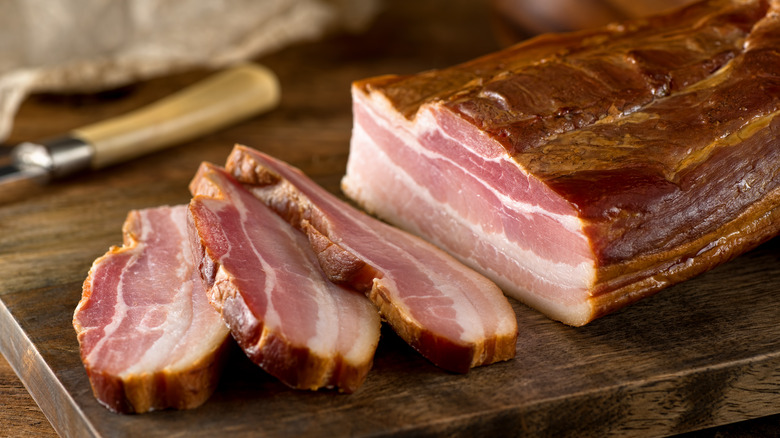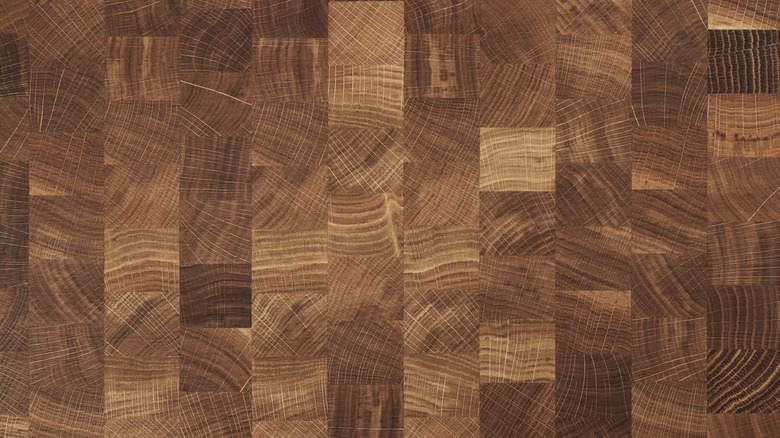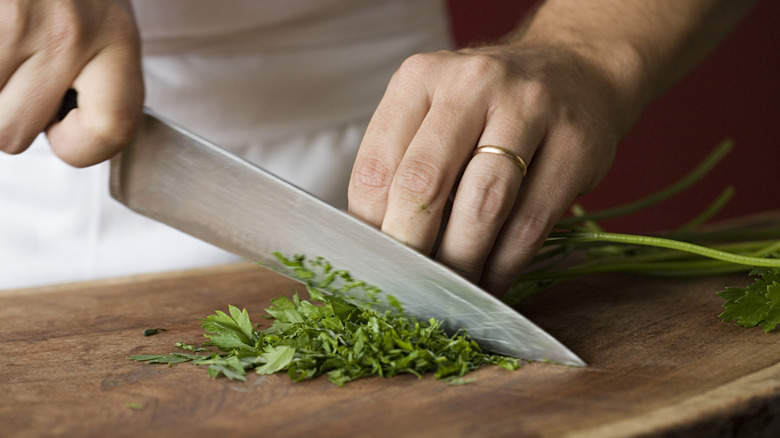What's The Difference Between A Cutting Board And A Butcher Block?
It's difficult to imagine any recipe that doesn't involve any sort of knife work. Knowing how to chop, dice, and slice like a pro is essential to making almost any meal. A knife is arguably the most essential kitchen tool, but you can't just do your cutting anywhere in your kitchen. In order to keep your kitchen free from nicks and scratches, you'll need some sort of cutting surface to work on. When buying a new cutting board, pay attention to the material, as all boards are not created equal.
Two common surfaces that you can do your knife work on are cutting boards and butcher blocks. Put simply, the difference between cutting boards and butcher blocks comes down to functionality. Most of your basic kitchen knife work can easily be done on a basic board, but when you're doing bigger cooking tasks– namely, carving into massive hunks of meat– the thicker, sturdier, and heavier wooden butcher block is going to be much more effective for safe and secure cutting.
What is a butcher block?
A cutting board can be made from many different materials. This includes plastic, glass, and even wood. Cutting boards can come in a wide variety of thicknesses– most of you likely have a thin plastic board in your kitchen for minor kitchen tasks.
A butcher block isn't simply a wooden cutting board, because it is commonly crafted out of end grain wood. Essentially, this refers to a piece of wood that is cut off of the larger wood source at a right angle to the natural grain, or striations, present on the inside of a tree. Numerous small pieces of wood cut to expose the aforementioned end grain are glued together in order to form a butcher block. The wood fibers that are exposed in an end grain chunk of wood will slowly bond back together after they've been cut through with your kitchen knife, which means that a butcher block is more resilient and has a longer lifespan than a cutting board.
Butcher blocks made out of edge grain wood, which showcases the arguably more aesthetically appealing linear nature of longer wood grain, are also an option. Some will argue that an edge grain butcher block is less durable, and even that inherently, only end grain construction constitutes a butcher block. At the end of the day, which butcher block you choose is really a matter of personal preference.
When to use a butcher block and cutting board
Though it's unlikely that you'll be deconstructing a whole hog in your kitchen, when you're attempting to break down, or butcher, large pieces of meat, a butcher block is the obvious choice. Some facets of meat preparation will require you to put considerable strength behind your knife stroke, which makes the resilience of a thick butcher block necessary. The surface of certain cutting boards can also do more to dull your knife. In particular, using a glass cutting board is a death sentence for your knife.
As previously mentioned, for just about every other kitchen task, be it chopping herbs or dicing veggies, a cutting board will suffice. Though you can technically use a cutting board for all the same tasks as you would a butcher block, it's still suggested that you use a thicker wooden cutting board. The most important attribute of a butcher block is its weight. The sheer weight of a butcher block makes slips less of a concern, which will keep your meat safe from falling on the floor, and more importantly, you safe from an errant blade.
The long-lasting nature and the slip-resistant heft of a butcher block make it the perfect present for those who love to cook. Before you buy a butcher block, you should be informed how it differs from a cutting board, and what these differences mean for its intended purposes.


